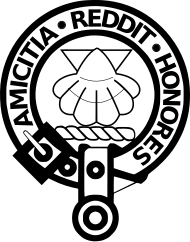Clan Pringle
| Clan Pringle | |
|---|---|

Crest: An escalop or
|
|
| Motto | Amicitia Reddit Honores (Friendship Gives Honour) |
| Profile | |
| Region | Scottish Borders |
 |
|
| Clan Pringle has no chief, and is an armigerous clan | |
| Seat | Torsonce |
| Historic seat | Hoppringle |
| Last Chief | John Hoppringle of that Ilk and Torsonce |
| Died | 21 December 1737 |
Clan Pringle is an Armigerous clan from the Scottish Borders.
According to the detailed book 'The Records of the Pringles', the surname Hoppringill, or Pringle, dates from the reign of Alexander III of Scotland (1249–86) and is one of the oldest names of the Scottish Border region.
Pringle is a placename derived from a locale in the Parish of Stow on the right side of Gala Water, about ten miles North of Galashiels. Hoppringle lies about one half mile up from the bank of the river on the Southern slopes of a ridge separating the valleys of the rivers Armet and Todhole (now named Armet Water and Toddle Burn).
This ridge, with its level crest, abuts at its Western extremity on the Gala in a remarkably rounded knob some 300 ft above the level of the river, which winds around its base in a semi-circle. It is this ring-like boss which no doubt gives the place its name of Hoppringhill, as it is occasionally written in older records.
The first syllable is the name Hope, Hopp, Op orUp, derived from the Old Norse Hop - a haven, denoting a small enclosed valley branching off a larger one. The other syllables include ring (or rink ), and hill. As such names are always descriptive, Hoppringill means simply the small enclosed valley of the ring, or round hill.
The full name of Hoppringill was in use for 300 years. The last recorded usage in its full form is by a Chief of the Clan whose will, dated 1737, is in the name of John Hoppringle of that Ilk. Around 1590, however, Pringill, which had appeared rarely before, begins to become the dominant form, until around 1650, when it gave way to Pringle. This change closely follows similar changes in the spelling of words like Temple and Single, derived from Tempill and Singill. The final syllable was never actually pronounced gill.
In the 14th century the family were close allies of the Earls of Douglas, to whom they were squires, and about the end of that era they are first defined as Hoppringle of that Ilk, holding the lands of Earlside in Lauderdale. Descendants were much in evidence at the Courts of James IV and V, at least two being trumpeters in the tail of James IV and one falling at his side at Flodden in 1513. For 100 years, from about 1489, a succession of Pringle ladies, usually younger daughters, were Prioresses of the Convent at Coldstream. The association of Pringles with the woollen industry may be traced to 1540 when one of their name held the responsibility for overseeing the shearing, storage and transportation of the wool from the King’s sheep. In 1592 various Pringles appeared before the King, with other Border lairds, giving an oath to faithfully serve the Wardens of the East and Middle Marches, and evidence of their extended land-holdings is shown by no less than six cadet families standing surety, one for the other, in keeping the peace. Five years later, Pringle of that Ilk and Pringle of Smailholm subscribed to a Bond of Manrent, taking it upon themselves the burden of ensuring the good behavior of Pringles in general. The last Pringle of that Ilk died in 1737, after which the principal family became the Pringles of Stitchill, the lands of which were acquired c.1630. Of this latter house, Sir Robert was created a Baronet of Nova Scotia in 1683 and, although the lands have now been sold, the Baronetcy has survived into the 21st century.
...
Wikipedia
